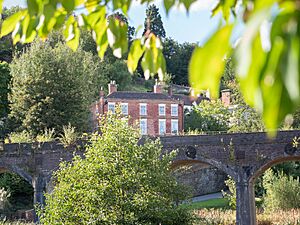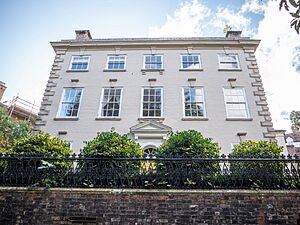Darby Houses facts for kids
The Darby Houses museum is a special place in Coalbrookdale, Shropshire, England. It's part of the ten Ironbridge Gorge Museums and is located in the Ironbridge Gorge, which is a World Heritage Site. This area is famous as the birthplace of the Industrial Revolution, a time when new machines and factories changed the world.
The Darby Houses are actually two homes right next to each other: Dale House and Rosehill. Both were built for members of the important Darby family, who were key figures in the Industrial Revolution.
What are the Darby Houses?
The Darby Houses museum helps visitors understand what life was like for the Darby family, who were famous for their work with iron. These houses show how people lived and worked during the early days of the Industrial Revolution.
Dale House: A Home for Iron Pioneers
Dale House was built in 1717 for Abraham Darby I. He was a very important person who found a new way to make iron using coke, which helped kick off the Industrial Revolution. This house looks out over a pool that once powered the blast furnace, where iron was made.
Later, Abraham Darby I's son, Abraham Darby II, and his wife, Abiah Darby, lived here with their children. They moved to a new house in 1750. The house was made bigger over time. In 1776, Abraham Darby III added a third floor by changing the attic. For a while in the 1900s, it was split into apartments. But now, it has been carefully restored to look as much as possible like it did in the 1700s. It is a Grade II listed building, which means it's an important historical building protected by law.
Rosehill: Another Family Home
Rosehill was built around 1738 for Richard Ford. He married Mary, who was Abraham Darby I's oldest daughter. Richard worked for the Coalbrookdale Company, first as a clerk and later as the manager of the Ironworks.
In the mid-1800s, Abraham Darby III's youngest son, Richard, and his wife, Maria, lived in Rosehill. After Richard passed away, his daughter Rebecca lived there until 1908. The house was in very bad shape, but it has been beautifully restored. It now looks like it did around 1850, showing how the family lived during that time. Rosehill is also a Grade II listed building, just like Dale House.



